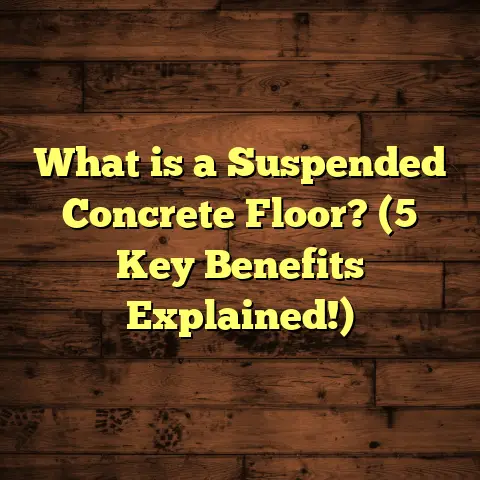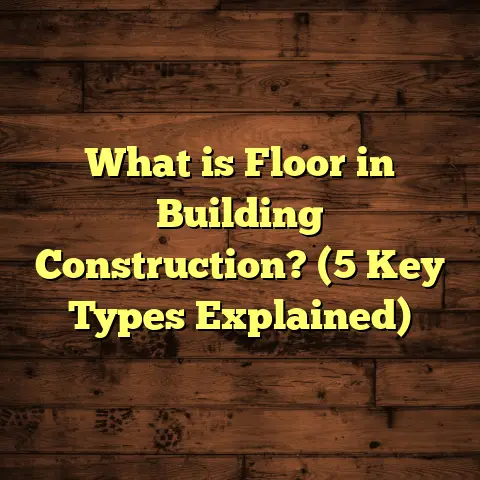What is a Floating Wood Floor? (5 Benefits You Need to Know)
Have you ever wondered how to get that beautiful wood floor look
without all the hassle of traditional installation? Maybe you want a
floor that looks great, feels sturdy, and doesn’t require permanent
adhesion to your subfloor. If that’s the case, then I want to talk
about floating wood floors. They’re a fantastic option for many homes,
and I’ve worked on plenty of installations where floating floors were
the perfect fit.
What Is a Floating Wood Floor?
So, what exactly is a floating wood floor? Simply put, it’s a type of
flooring that isn’t nailed, glued, or otherwise fixed to the subfloor.
Instead, the planks or tiles are installed over an underlayment and
“float” above the base layer. The individual boards lock together with
a tongue-and-groove or click-lock system, creating a solid surface
without being attached directly to the floor beneath.
You might wonder why this matters. Well, floating floors offer more
flexibility during installation and can adapt better to temperature and
humidity changes because they can expand and contract naturally.
They’re commonly made from engineered wood or laminate but can also be
vinyl or other composite materials designed to mimic real wood.
How Floating Wood Floors Work
The secret lies in the construction. Most floating floors have a core
layer made from dense fiberboard or plywood, topped with a thin layer
of real wood veneer or an image layer that gives the appearance of
wood. The underlayment below the floor helps with moisture control,
sound reduction, and cushioning.
When you click the boards together, they create a tight seam that locks
the whole floor into place. This means the entire floor moves as one
piece rather than individual boards shifting separately.
The Anatomy of Floating Wood Floors
Let me break down what makes floating floors tick. There are three main
components:
- Top Layer (Wear Layer): This is what you actually see and walk on.
It’s either a thin slice of real hardwood (engineered floors) or a high- resolution photographic layer (laminate). The wear layer is coated with
tough finishes to resist scratches and dents. - Core Layer: Usually made of high-density fiberboard (HDF) or plywood.
This core provides stability and strength while allowing some flexibility. - Underlayment: Sits beneath the core layer—often foam or cork—which helps
reduce noise, adds cushioning, and acts as a moisture barrier.
This combination creates a floor that looks and feels like wood but is easier to install and maintain.
Why Floating Wood Floors Are Gaining Popularity
From my experience, floating floors have become increasingly popular
because they combine style, practicality, and ease of installation. I’ve
seen homeowners who want the look of hardwood but don’t want to deal
with the mess or permanence of nails and glue. Floating floors offer a
middle ground—durable and attractive but less invasive to install.
Let me share a quick story: I was helping a family renovate their living
room, and they were on a tight budget but wanted something modern and
warm. Floating engineered hardwood was perfect because we could install
it in just a couple of days without disrupting the rest of the house.
Plus, if they ever want to replace it or move it to another room, it’s
relatively easy.
I’ve noticed this trend in many projects: people want flexibility in their flooring choices without sacrificing the look and durability of real wood. And floating floors deliver that balance well.
5 Benefits You Need to Know About Floating Wood Floors
Now let me walk you through five benefits that really stand out when you choose floating wood floors. These are based on my hands-on work with installations as well as feedback from homeowners.
1. Easy Installation Saves Time and Money
One of the biggest advantages I’ve noticed is how fast floating floors go down compared to traditional hardwood. Because you don’t have to nail or glue each plank, installation is much faster. This means fewer labor hours and lower costs.
For example, on average, a professional installer can lay about 100 to 150 square feet of floating flooring in a day. That’s almost double what it takes to do nail-down hardwood in many cases.
If you’re a DIY fan like me, floating floors are also more forgiving and don’t require specialized equipment like nail guns or adhesives. You just need the right tools for cutting and locking the boards together.
I often use FloorTally when estimating costs for these projects. It helps me quickly calculate material needs and labor based on local prices. It even factors in waste so I’m not caught short on planks. Having this tool means I can give clients realistic budgets without running multiple quotes.
A Real-Life Example: A client once called me after trying to install traditional hardwood themselves for weeks with little progress. When we switched to floating engineered flooring, the installation was done in just three days—and turned out beautiful.
2. Suitable for Many Subfloors and Environments
Floating floors can be installed over several types of subfloors: concrete, plywood, even old vinyl or tile if it’s level enough. This versatility makes them ideal for basements or rooms where moisture might be a concern.
In one basement project I did, the homeowner was worried about moisture damaging a glued-down hardwood floor. A floating floor with moisture-resistant underlayment was the perfect solution. It allowed airflow underneath and prevented warping.
Technical Insight: Concrete slabs can emit moisture that ruins traditional glued floors unless special barriers are used. Floating floors’ underlayment systems often include vapor barriers which help keep moisture away from the wood core.
I recommend testing subfloor moisture levels before installation with a moisture meter—something I always do on site—to ensure compatibility with floating floors.
3. Comfort and Sound Absorption
Because floating floors sit on an underlayment, they offer extra cushioning underfoot compared to glued or nailed hardwood. This makes walking around more comfortable, especially for long periods.
The padding also helps reduce noise — both sound traveling between floors and footstep sounds inside the room. In an apartment project I worked on, tenants mentioned how much quieter their upstairs footsteps became after we installed floating floors.
There are also different types of underlayments you can choose depending on your needs — cork for natural sound absorption or rubber for heavier impact noise reduction.
Did you know? Studies show floating floors with quality underlayment can reduce sound transmission by up to 20 decibels compared to hard surfaces without cushioning.
4. Expands and Contracts with Temperature Changes
Wood naturally expands and contracts with humidity and temperature shifts. Floating floors are designed to move slightly as a whole piece rather than having individual boards shift unevenly.
This means fewer gaps or buckling issues over time when compared to glued floors that don’t have space to move freely.
In climates with big seasonal changes like where I live, this flexibility prevents many headaches down the road.
Pro Tip: Always leave an expansion gap around the edges during installation—about 1/4 inch—to give the floor room to move without buckling against walls or door frames.
5. Easier to Repair and Replace
If damage happens—a scratch here, a chip there—floating floors are easier to repair because you can remove individual planks without pulling up the whole floor.
When I helped a client fix water damage after a pipe leak, we were able to replace only the affected boards rather than replacing or refinishing the entire floor.
This modularity also makes it easier if you want to update your flooring section by section over time instead of all at once.
Personal Stories That Show the Value of Floating Floors
I want to share some stories from my own work that highlight these benefits in real-life situations.
Story 1: The Busy Family Living Room Makeover
A family I worked with had two energetic kids and pets—plus a hectic schedule that made construction disruption difficult. They wanted new floors but had concerns about cost and mess.
We chose engineered hardwood planks installed as floating floors over their existing plywood subfloor. Because we didn’t have to glue or nail down every board, installation finished faster than expected—just two days total for their 500 sq ft room.
The family loved how durable yet warm the floor felt underfoot—and how easy it was to clean after their kids tracked in dirt from outside.
Story 2: Basement Conversion Success
Another time I helped convert an unfinished basement into a cozy entertainment room with floating flooring over concrete slab.
The key challenge was moisture control since basements tend to be damp spaces prone to mold risks if not properly managed.
We used a specialized underlayment with vapor barrier properties designed for concrete subfloors plus engineered planks rated for basement use.
The result was a warm wood-look floor that stayed stable year-round despite humidity fluctuations—and no signs of warping or buckling even after several years.
Deep Dive: Installation Process Tips Based on My Experience
If you’re thinking about installing floating wood floors yourself or supervising your contractor, here are some practical tips from my years in flooring:
Preparing Your Subfloor
- Clean thoroughly: Remove dust, debris, old adhesives, nails—anything that could interfere with laying your new floor flat.
- Leveling matters: Use leveling compounds for dips or uneven spots greater than 3/16 inch over 10 feet.
- Moisture check: Use a moisture meter especially on concrete slabs; ideal levels should be below 3% for wood products.
- Acclimate planks: Let wood planks sit in your home environment for at least 48 hours before installation so they adjust to humidity levels.
Laying Underlayment
- Roll out your underlayment carefully across the entire area.
- Tape seams if recommended by manufacturer instructions.
- Make sure there are no wrinkles or folds that could cause unevenness later.
Locking Boards Together
- Start along one wall; most manufacturers suggest working left to right.
- Use spacers along edges to maintain expansion gaps.
- Click boards firmly into place — sometimes tapping lightly with a rubber mallet helps.
- Stagger end joints by at least 6 inches between rows for stability and appearance.
- Cut boards carefully using appropriate saws (miter saws work best for straight cuts).
Finishing Touches
- Install trim and transition strips without nailing into your floating floor—attach them only to walls.
- Remove spacers once all boards are locked down.
- Clean up surface dust before moving furniture back in.
Cost Insights: How I Estimate Flooring Projects Efficiently
Budgeting any flooring project can be tricky because prices vary widely depending on material quality, labor rates, location, room size, and prep work needed.
For years now I’ve relied on tools like FloorTally to help me estimate costs quickly with accuracy. Here’s why it’s been so useful:
- Local pricing: It pulls current local rates for materials AND labor so estimates reflect actual market conditions.
- Waste factor: Automatically includes extra material needed (usually around 5-10%) so I don’t run short mid-installation.
- Material variety: I can input different flooring types—engineered wood, laminate, vinyl—to see how costs compare side by side.
- Time saver: Instead of juggling multiple spreadsheets or chasing quotes from suppliers and installers separately, everything is consolidated in one place.
- Easy adjustments: If clients want upgrades or change flooring styles mid-project planning, re-running budgets is straightforward without starting over.
- Project management: These estimates become my baseline budgets which I update as work progresses—keeping clients informed every step of the way.
Example: For a 700 sq ft living/dining room project using mid-grade engineered floating wood flooring with professional installation here in my city:
- Material cost: $4-$6 per sq ft
- Labor cost: $3-$5 per sq ft
- Total estimated budget: $4,900 – $7,700 (including waste)
This range helps clients plan realistically before committing financially or starting demo work.
Common Questions I Hear About Floating Wood Floors
I get asked all sorts of questions about floating floors during consultations. Here are some you might be wondering too:
Can Floating Floors Be Installed Over Radiant Heating?
Yes! Many engineered wood products designed for floating installation work well over radiant heat systems because they handle temperature changes better than solid hardwood nailed-down floors.
However, you must check manufacturer guidelines carefully since some products have temperature limits or require special underlayments compatible with heating systems.
How Durable Are Floating Floors Compared to Traditional Hardwood?
High-quality engineered wood floating floors can be just as durable as nail-down hardwood when maintained properly. The wear layer thickness matters—a thicker veneer (3-4 mm) lasts longer before refinishing is needed versus thinner layers (1-2 mm).
Laminate floating floors are generally more scratch-resistant but less repairable than real wood surfaces.
Are Floating Floors Noisy?
Not if installed correctly with good underlayment! The padding underneath reduces hollow sounds often associated with laminate or engineered planks installed without proper cushion layers.
If noise is a major concern (like in apartments), consider rubber-based underlayments designed specifically for sound reduction.
Can I Refinish Engineered Floating Floors?
You can refinish engineered wood floors if they have thick enough wear layers (above 3 mm). However, since most floating engineered floors have thinner tops compared to solid hardwood (which can be sanded multiple times), refinishing options may be limited—usually once or twice at most before needing replacement.
Maintenance Tips From My Experience
Keeping your floating wood floor looking great isn’t difficult if you follow some basic care routines:
- Sweep/vacuum regularly using soft-bristle brushes or vacuum attachments designed for hard floors.
- Wipe up spills immediately to prevent moisture seeping into seams.
- Use mats/rugs near entryways to trap dirt/grit that can scratch surfaces.
- Avoid wet mopping: Use damp mops designed for wood floors; excess water damages edges.
- Trim pet nails regularly if you have animals.
- Use felt pads under furniture legs when moving items around.
- Reapply finish coatings when wear becomes apparent (check product recommendations).
Case Study: From Old Vinyl To Modern Floating Wood Floor
A client reached out wanting to upgrade their tired vinyl kitchen floor but was worried about demolition mess and cost overruns. After inspecting their subfloor—smooth concrete slab—we agreed on installing an engineered wood floating floor over an underlayment with moisture barrier qualities.
The project went smoothly:
- Prep took one day (cleaning & leveling)
- Installation took two days for 400 sq ft
- Cost stayed within projected budget thanks to thorough estimates via FloorTally
- Homeowner loved how warm and stylish their kitchen felt afterward
- No lingering odors or mess typical of glue-down jobs
I followed up six months later, and they reported zero issues—no swelling or gaps despite kitchen humidity from cooking!
Final Thoughts From My Flooring Experience
Floating wood floors offer an excellent blend of style, comfort, durability, flexibility, and cost-effectiveness. Whether you’re remodeling your home or upgrading rental spaces, they make practical sense without sacrificing that classic wood look we all love.
With advances in materials and locking technologies over recent years, floating floors now outperform many older methods on speed of installation and long-term performance metrics.
If you’re considering new flooring but feel overwhelmed by options—think about giving floating engineered hardwood a serious look. And if you want help planning your project realistically without hidden surprises on price or timeline—I’m here anytime to share more insights based on what I’ve learned firsthand working on hundreds of projects just like yours.
Got questions about specific brands? Installation challenges? Maintenance advice? Just ask—I’m happy to chat more about making your flooring project both easy and beautiful!





